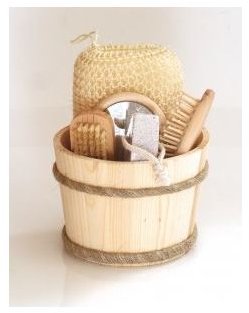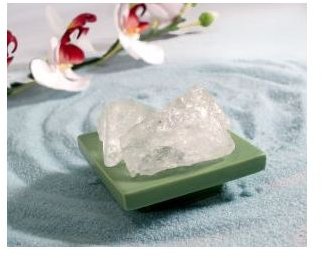Epsom Salt Bath: Learn the Many Benefits & Know How to Take One
What is Epsom Salt?
Often thought of as a salt due to its name, Epsom salt is in fact a pure mineral. Its name derives from a spring in Surrey, England called Epsom. The reason for being referred to as a salt is due to its resemblance to it. Epsom salt is free of any sodium chloride, which is the main component in all salts, including sea salts.
Epsom salt consists of two key elements: magnesium and sulfur. These two minerals are difficult to ingest, but they are easily absorbed through the skin, as when taking an Epsom salt bath to provide healing and nourishing benefits. The Epsom Salt Council states, “Magnesium can be ingested as a nutritional supplement, but studies show that a wide variety of factors - the presence of specific foods or drugs, certain medical conditions, even the individual chemistry of a person’s stomach acid - can interfere with their effectiveness. But all of the subjects in a recent study experienced increased magnesium levels from soaking in a bath enriched with magnesium sulfate crystals, commonly known as Epsom Salt.”
Epsom salt is a FDA-approved laxative for ingestion and it can be used for detoxification purposes, such as removing gallstones, which requires a specific diet with Epsom salt. Otherwise, the most common use for Epsom salt is bathing with it as the overall detoxification of the body can be done more effectively through this method, without experiencing the laxative effects caused to the digestive system.
Taking a Bath with Epsom Salt to Relieve Muscle and Joint Pain
An Epsom salt bath is an excellent remedy for muscle and joint pain relief, as it helps prevent inflammation throughout the body. Due to the sulfate present in Epsom salt, toxins are flushed from the body to relieve any muscle soreness or pain. This detoxification process creates an unique reverse osmosis system when the body is infused in it when bathing. This process triggers the body to remove harmful toxins and absorb important minerals, such as the mineral magnesium present in salt.
It also helps restore the normal functions of the body and regulates electrolysis, which helps the muscles function properly. According to SaltWorks.us, “Studies show that Epsom salt can help regulate electrolytes in your body, ensuring proper functioning of the muscles, nerves and enzymes. Magnesium is also known to be critical in the proper use of calcium, which serves as a main conductor of the electric impulses in your body.”
Relaxation and Ease of Stress
Magnesium is an essential element present in the body responsible for many vital bodily functions. According to the National Institutes of Health, “Magnesium is needed for more than 300 biochemical reactions in the body.” There is no doubt that these days many people are deficient in this important mineral. Magnesium deficiency can cause many health issues, such as cardiovascular problems, weakness and chronic fatigue, arthritis and digestive problems. In such cases, magnesium supplements are prescribed to restore the body to its normal health. Although an important mineral, magnesium is not easily digested by the body and the best way to provide the body with its benefits is to take an Epsom salt bath, which contains a high quantity of both magnesium and sulfate. Magnesium is easily absorbed by the body through skin.
Stress is one of the main causes of magnesium deficiency. The restoration of magnesium through soaking in a bath can help restore the proper levels needed by the body and thus relieve stress. Magnesium is also responsible for producing serotonin in the body, which induces the feeling of relaxation and calmness. Epsom salt baths can also increase energy and build stamina. Experts recommend taking a bath with Epsom salt at least three times a week to help gain more energy and look and feel better overall.
Beauty Restoration
An Epsom salt bath can help restore healthy skin. Soaking in a bath tub or directly applying Epsom salt can soften the skin as well as exfoliate it. Likewise, it can remove blackheads and bring volume to the hair when applied to it. Its detoxification effects unclog pores and clean the body inside out, providing freshness and youthfulness.
Method of Taking an Epsom Salt Bath

Add 1 to 2 cups of Epsom salt to your bath and soak for 10 to 20 minutes. Make sure the bath water is at the warmest tolerable temperature to increase the absorption of Epsom salt in the skin. Let the salt dry on the body after the bath and apply a moisturizing cream if the skin becomes too dry. The magnesium in the Epsom salt will continue to absorb in the skin after the bath.
You can also make an Epsom salt foot bath. Add a cup of Epsom salt to a small tub and add warm water. Soak your feet in the water to relieve tension and provide relief.
References
National Institutes of Health: Magnesium - https://ods.od.nih.gov/factsheets/magnesium.asp
Epsom Salt Council: The Science of Epsom Salt - https://www.epsomsaltcouncil.org/about_science_of_epsom_salt.htm
SaltWorks.us: Epsom Salt Uses and Benefits - https://www.saltworks.us/salt_info/epsom-uses-benefits.asp
Image References:
Stock.xchng: Salt sole by Elayne Wong
Stock.xchng: Simple bath set by Jozsef Szasz-Fabian
Disclaimer
Please read this disclaimer regarding the information contained within this article.
